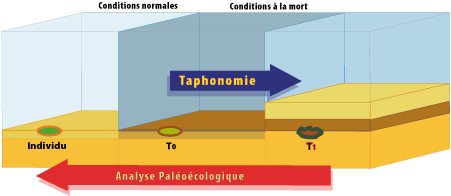
DEATH

| definitions | comments | | portal |
The Death

Death is the initial stage represented by T0, from which begin the taphonomic process, the beginning of attempt of the transition of an entity towards the fossil register.
The Individual cannot be separated from its environment, because living within a population, defined as “a group of individuals of the same species occupying a niche in a given biocenosis”, and therefore in a biocenosis, which is defined as “all the populations linked by a reciprocal dependence and now permanent manner in reproducing in a biotope”.
Three types of death may occur for the individual. Nevertheless the instantaneous character of the death remains a delicate point to be estimated when compared to the geological time scale.
- 1 - natural death that, for a lot of groups, leads rarely to the fossil register, except as fragments and debris of various sizes, according to the action of the prevailing factors governing the biotope in which death occurred;
- 2 - death by predation often leads to the same result as the above-mentioned. Sometimes, the predator can be identified and its effects analysed, e.g. perforations by gastropods. For those two types, the death of individuals belonging to the same species is displayed, sometimes over several tens of thousands of years (Emig, 1987).
- 3 - death under drastic changes, sometimes “catastrophic”, of the environmental conditions, concerning generally many individuals, a whole population or several populations, a biocenosis or several ones with harsh biotope modifications. In this case, all age classes are affected. Such changes may induce a shortening of the stage of alteration and an acceleration of that of fossilisation, e.g. effects of a period of rapid sedimentation. In addition, the responsible factors should be identified in the geological layer, while the conditions in T0 cannot be interpreted as normal life conditions.
In each of those three types of death, there is always the possibility of a mixing of populations or individuals, even in life position, which may belong to the different biocenoses or/and to different geological periods. Still it is difficult to localise the death within the geological time scale, as the dating of each fossil is obviously impossible. Consequently, only an excellent knowledge of the ecology of the populations, the cause of the death of the individuals, as well as the general ecological conditions that prevailed, may allow one to specify the moment of death for each fossil.
More than the direct causes inducing the death of the individual, the environmental conditions (sometimes largely overlooked in the taphonomic processes and in the paleoecological reconstruction) prevailing at the moment of the death will induce the post-mortem loss of information during the taphonomic transition, as well as the potential of fossilisation of the dead individuals - i.e., the morpho-anatomical characteristics.
© 2007 by CdM Créations
![]()